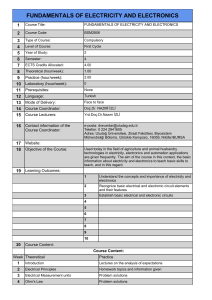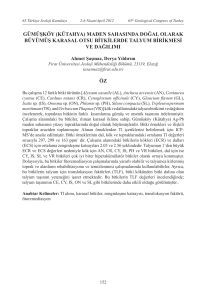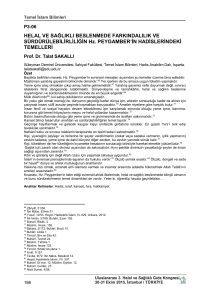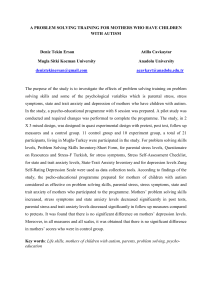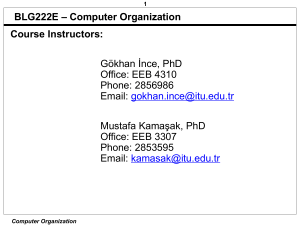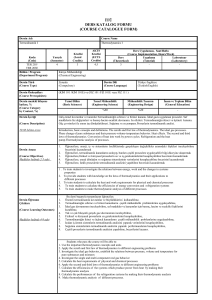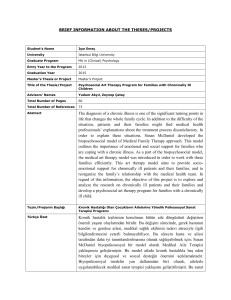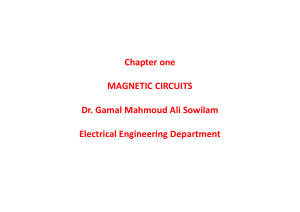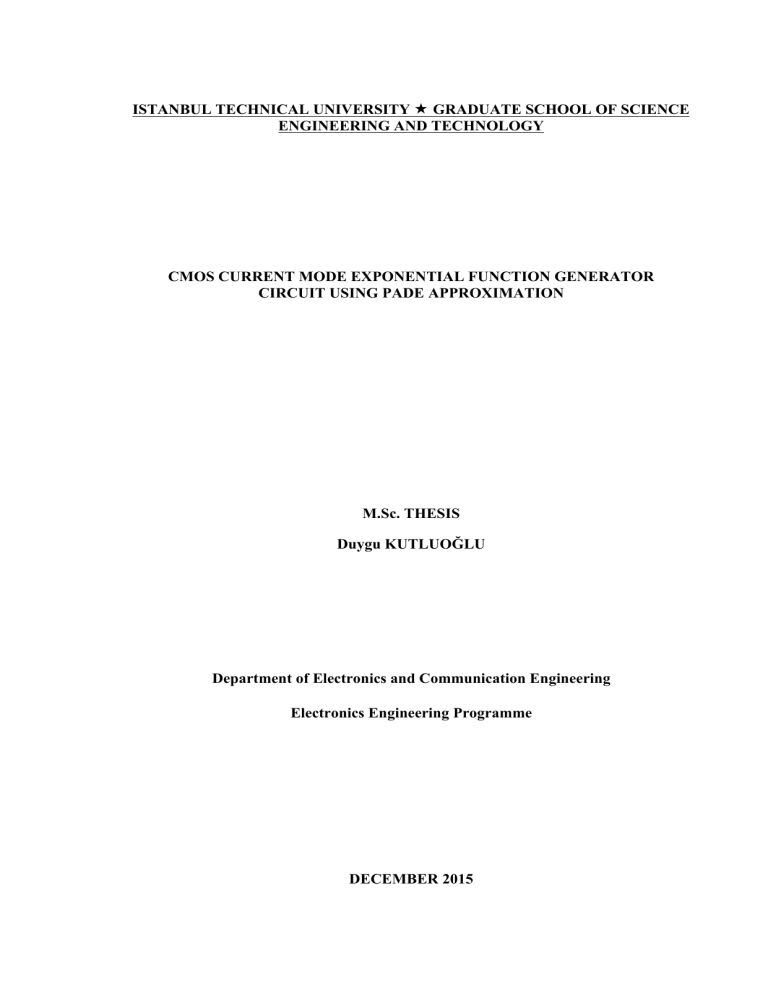
ISTANBUL TECHNICAL UNIVERSITY « GRADUATE SCHOOL OF SCIENCE
ENGINEERING AND TECHNOLOGY
CMOS CURRENT MODE EXPONENTIAL FUNCTION GENERATOR
CIRCUIT USING PADE APPROXIMATION
M.Sc. THESIS
Duygu KUTLUOĞLU
Department of Electronics and Communication Engineering
Electronics Engineering Programme
DECEMBER 2015
ISTANBUL TECHNICAL UNIVERSITY « GRADUATE SCHOOL OF SCIENCE
ENGINEERING AND TECHNOLOGY
CMOS CURRENT MODE EXPONENTIAL FUNCTION GENERATOR
CIRCUIT USING PADE APPROXIMATION
M.Sc. THESIS
Duygu KUTLUOĞLU
(504091263)
Department of Electronics and Communication Engineering
Electronics Engineering Programme
Thesis Advisor: Prof. Dr. Ali TOKER
Anabilim Dalı : Herhangi Mühendislik, Bilim
Programı : Herhangi Program
DECEMBER 2015
İSTANBUL TEKNİK ÜNİVERSİTESİ « FEN BİLİMLERİ ENSTİTÜSÜ
PADE YAKLAŞIKLIĞI KULLANAN AKIM MODLU CMOS
EKSPONANSİYEL FONKSİYON ÜRETİCİ DEVRESİ
YÜKSEK LİSANS TEZİ
Öğrenci Duygu KUTLUOĞLU
(504091263)
Elektronik ve Haberleşme Anabilim Dalı
Elektronik Mühendisliği Programı
Tez Danışmanı: Prof. Dr. Ali TOKER
Anabilim Dalı : Herhangi Mühendislik, Bilim
Programı : Herhangi Program
ARALIK 2015
Duygu Kutluoğlu, a M.Sc. student of ITU Institute of Science, Engineering and
Technology student ID 504091263, successfully defended the thesis entitled
“CMOS CURRENT MODE EXPONENTIAL FUNCTION GENERATOR
CIRCUIT USING PADE APPROXIMATION”, which she prepared after
fulfilling the requirements specified in the associated legislations, before the jury
whose signatures are below.
Thesis Advisor :
Prof. Dr. Ali TOKER
İstanbul Technical University
Jury Members :
..............................
Doç. Dr. Metin YAZGI
..............................
İstanbul Technical University
Prof. Dr. Name SURNAME
.............................
İstanbul Technical University
Doç. Dr. Bilgin METİN
..............................
Boğaziçi University
Prof. Dr. Name SURNAME
..............................
İstanbul Technical University
Prof. Dr. Name SURNAME
İstanbul Technical University
Date of Submission : 24 November 2015
Date of Defense
: 23 December 2015
v
vi
FOREWORD
I would like to thank my advisor Prof. Dr. Ali TOKER, who always believed in me, for
all his guidance, supports and encouragements to me. With his vision, he changed my
life forever.
In addition, I am earnestly thankful to Prof. Dr. Serdar ÖZOĞUZ for all his efforts and
spending valuable time on my thesis. Without him, I cannot do this work.
December 2015
Duygu KUTLUOĞLU
Electronics Engineer
vii
viii
TABLE OF CONTENTS
Page
FOREWORD ........................................................................................................... vii
TABLE OF CONTENTS ......................................................................................... ix
ABBREVIATIONS ................................................................................................... xi
LIST OF TABLES .................................................................................................. xiii
LIST OF FIGURES ................................................................................................. xv
SUMMARY ............................................................................................................ xvii
ÖZET ....................................................................................................................... xix
1. INTRODUCTION ................................................................................................. 1
1.1 Variable Gain Amplifiers and Their Control Functions .................................... 1
1.2 Motivation .......................................................................................................... 3
1.3 Thesis Orientation .............................................................................................. 4
2. EXPONENTIAL FUNCTION APPROXIMATIONS ....................................... 5
2.1 Taylor Series Approximation ............................................................................. 5
2.2 Pseudo Exponential Approximation .................................................................. 6
2.2.1 Pseudo Exponential Function with Optimizated Coefficient Values ......... 7
2.2.2 United Taylor Series and Pseudo Exponential Approximation .................. 9
2.3 Pade Approximation ........................................................................................ 11
3. EXPONENTIAL FUNCTION GENERATOR (EXPFG) EXAMPLES ........ 17
3.1 A Pseudo-Exponential Function Generator ..................................................... 17
3.2 A Superior Order Taylor Series Approximation Exponential Function
Generator................................................................................................................ 18
3.3 A New United Taylor Series and Pseudo Exponential Approximation ........... 20
3.4 Performance Comparison Between Different Exponential Approximations
Approaches ............................................................................................................ 21
4. DESING OF A NEW EXPFG USING PADE APPROXIMATION ............... 23
4.1 A New Exponential Function Approximation Using Pade Approximation .... 23
4.2EXPFG Generatır Circuit Using PADE(1,2)x(2,1) ................................................ 26
4.2.1 Circuit Design ........................................................................................... 26
4.2.2 Multiplier/Divider ..................................................................................... 27
4.2.3 Circuit Realisation and Simulation Results .............................................. 30
4.3 EXPFG Generatır Circuit Using PADE(2,0)x(0,2) ............................................... 33
4.4 EXPFG Generatır Circuit Using PADE(1,1)...................................................... 35
4.5 Chapter Summary ............................................................................................ 37
5. CONCLUSIONS AND RECOMMENDATIONS ............................................ 39
REFERENCES ........................................................................................................ 41
CURRICULUM VITAE ......................................................................................... 45
ix
x
ABBREVIATIONS
AAC
AGC
EXPFG
VGA
WCDMA
WPAN
WSN
: Adaptive Atenna Combining
: Automatic Gain Control
: Exponential Function Generator
: Variable Gain Amplifier
: Wideband Code-Division Multiple Access
: Wireless Personal Area Networks
: Wireless Sensor Networks
xi
xii
LIST OF TABLES
Page
Table 2.1 : A portion of the Pade table for ex.. ......................................................... 11
Table 2.2 : Input ranges of Pade functions for different m and n values.. ................ 13
Table 3.1 : Performance comparison between different exponential approximations
approaches. ............................................................................................. 21
Table 4.1 : Input ranges of different conbination of exponential function
approximations with Pade functions of ex. ............................................. 26
Table 4.2 : Device dimentions of the designed multiplier/divider............................ 29
Table 4.3 : Circuit performance with different Pade functions. ............................... 37
xiii
xiv
LIST OF FIGURES
Page
Figure 1.1 : A basic VGA Block. ............................................................................... 2
Figure 1.2 : Classification of VGAs in terms of the control functions. ...................... 3
Figure 2.1 : Error function of Taylor series approximation........................................ 5
Figure 2.2 : Comparison of Taylor series function and ideal exponential function. .. 6
Figure 2.3 : Error function of Pseudo Exponential approximation. ........................... 7
Figure 2.4 : Comparison of Taylor series function and ideal exponential function. .. 7
Figure 2.5 : Error function of pseudo exponential approximation with optimizing
coefficient ( a =0.75 and x >0). ............................................................... 8
Figure 2.6 : Comparison of the function and ideal exponential function ( a =0.75
and x >0). ................................................................................................ 8
Figure 2.7 : Error function of pseudo exponential approximation with optimizing
coefficient ( a =0.25 and x <0). ............................................................... 9
Figure 2.8 : Comparison of the function and ideal exponential function ( a =0.25
and x <0). ................................................................................................ 9
Figure 2.9 : Taylor and pseudo exponential approximation values and ideal
exponential function for k =0.15, k =0.25 and k =1.. ......................... 10
Figure 2.10 : Comparison of Taylor and pseudo exponential approximation values
and ideal exponential function for k =0.15. .......................................... 10
Figure 2.11 : Error function of Taylor and pseudo exponential approximation. ...... 11
Figure 2.12 : Error function of Pade approximation................................................. 11
Figure 2.13 : Comparison of ideal exponential function and Pade approximation
function for m=2, n=2.. ......................................................................... 12
Figure 2.14 : Comparison of Taylor series approximation and Pade approximation 13
Figure 2.15 : Error function of Taylor series approximation and Pade approximation.
............................................................................................................... 11
Figure 3.1 : The block diagram of EXPFG [25]. ...................................................... 18
Figure 3.2 : The simulation result of the proposed circuit [25]. ............................... 18
Figure 3.3 : The block diagram of EXPFG [24]. ...................................................... 19
Figure 3.4 : The block diagram of the proposed EXPFG [35]. ................................ 20
Figure 3.5 : Linear-in-dB characteristic of the proposed EXPFG [35]. ................... 21
Figure 4.1 : Linearity gain errors of exponential function approximations [33]. ..... 23
Figure 4.2 : Pade Approximations with different numerator and denominator orders.
............................................................................................................... 25
Figure 4.3 : The block diagram of the proposed exponential function generator..... 27
Figure 4.4 : Principle of multiplier/divider circuit [41]. ........................................... 27
Figure 4.5 : Circuit scheme of multiplier/divider circuit [41]. ................................. 28
Figure 4.6 : Stacked topology [41]. .......................................................................... 28
Figure 4.7 : Schematic of the Multiplier/Divider circuit. ......................................... 29
Figure 4.8 : Simulation result of the Multiplier/Divider circuit. .............................. 29
Figure 4.9 : Calculated output of proposed function. ............................................... 31
xv
Figure 4.10 : Current mode circuit realization of n1 , n2 , d1 and d 2 functions. ....... 31
Figure 4.11 : Circuit realization of proposed EXPFG. ............................................. 32
Figure 4.12 : The comparison of the ideal exponential function and the gain function
of the circuit in Figure 3.8. .................................................................. 32
Figure 4.13 : The error function of the output current. ............................................. 33
Figure 4.14 : The block diagram of the proposed exponential function generator. .. 33
Figure 4.15 : Circuit realization of proposed EXPFG. ............................................. 34
Figure 4.16 : The comparison of the ideal exponential function and the gain function
of the circuit in Figure 4.15. ................................................................ 34
Figure 4.17 : The error function of the output current. ............................................. 35
Figure 4.18 : The block diagram of the proposed exponential function generator. .. 35
Figure 4.29 : Circuit realization of proposed EXPFG. ............................................. 36
Figure 4.20 : The comparison of the ideal exponential function and the gain function
of the circuit in Figure 4.19. ................................................................ 36
Figure 4.21 : The error function of the output current. ............................................. 37
xvi
CMOS CURRENT MODE EXPONENTIAL FUNCTION GENERATOR
CIRCUIT USING PADE APPROXIMATION
SUMMARY
Over the past few years, as a result of the high demand to more powerful mobile
devices, the importance of the high speed wireless communication becomes greater
and greater. Automatic gain control (AGC) is necessary for controlling the signal
amplitude and maximizing the dynamic range of the communication systems. The
most important element of AGC loop is Variable Gain Amplifier (VGA). VGAs are
widely used in biomedical applications, in imaging and signal processing circuits as
well as the communication systems.
VGAs can be classified according to their control function. The control function can
be an analogue (continuous) signal or a discrete signal. The VGAs that are controlled
with continuous signal are either controlled with a linear signal or an exponential
signal. Exponential control signals are preferred because of their higher dynamic
range characteristics. To realize exponential signals, devices with exponential DC
characteristics can be used. Whilst CMOS technology lacks devices that have
exponential characteristics in linear or saturation regions, exponential function
approximations are used as the functions that will be realized with MOSFET devices
working in saturation region.
In the scope of this thesis work, first the exponential function approximations that are
used for designing the control blocks of VGAs are classified. It is found out that
Taylor series approximation, pseudo exponential approximation and their
combinations are mostly used in literature. Recently Pade approximation is also
reported in a work. Mathematical verifications are also presented for these
approximations using MATLAB. Second, the Exponential Function Generator
(EXPFG) circuit designs in literature are examined and a performance comparison of
these circuits are provided.
Moreover, a new exponential function approximation, using Pade approximations
proposed. Pade approximation is preferred because it provides a better result
compared to most common approximation method, Taylor series approximation with
the same order. Finally, three exponential function generator circuits are designed in
CMOS 0.35µm technology using the proposed approximation methodology. Their
performance is measured to verify the mathematical analysis using SPICE tool. The
results verified that Pade approximation equations can be used in design of EXPFGs
and a proper order of numerator and denominator can be selected according the
specifications of the VGA.
xvii
xviii
PADE YAKLAŞIKLIĞI KULLANAN AKIM MODLU CMOS
EKSPONANSİYEL FONKSİYON ÜRETİCİ DEVRESİ
ÖZET
Son birkaç yıl içinde, daha güçlü mobil cihazlara karşı oluşan yüksek talep, artan veri
transferi ve yüksek hız ihtiyacı sonucunda, yüksek hızlı kablosuz haberleşme
sistemlerinin önemi çok daha büyük hale geldi. Haberleşme sistemleri, bilginin işaret
genliğinde tutulduğu sistemler ve işaret genliğinin değişkenlik gösterebildiği veri
depolama sitemlerini içerdiğinden, sinyalinin genliğini kontrol etmek, gürültü
eşiğinin üzerinde tutabilmek ve sistemin dinamik aralığını maksimize etmek
haberleşme kalitesi için kritik rol oynamaktadır. Geniş dinamik aralığına ek olarak,
modern teknolojilerde yüksek frekans karakteristiği, düşük güç tüketimi, düşük
gürültü, düşük kırmık alanı, ısıl şartlara düşük duyarlılık gibi ihtiyaçlar da söz
konusudur. Bu ihtiyaçları karşılamak için kullanılan farklı teknolojiler ve bloklar
bulunmaktadır. Bu amaçlara hizmet eden özellikle de dinamik aralığı arttırmak için
kullanılan otomatik kazanç kontrolü devreleri haberleşme sistemleri için önemli
yapıtaşlarından biridir. Bu devreler giriş sinyalinin genliği ne olursa olsun, çıkış
sinyalinin genliğini sabit tutarak sistemin dinamik aralığını arttırırlar. Otomatik
kazanç kontrolü döngüsünde ise en önemli blok kazancı ayarlanabilir
kuvvetlendiricilerdir.
Elektronik sistemlerde işaretin bloklar arasındaki geçişi sırasında bloklara uyum
sağlayabilmesi, işaretin doğru algılanması ve işlenebilmesi açısından kritiktir.
İşaretin uyumlandırılması ihtiyacı, giriş işareti seviyesini uygulanacak elemanın giriş
seviyesine uyumlandırmak gerektiği veya sinyalin kayıplarını doldurarak giriş işareti
seviyesini sabitlemek gerektiği olduğu durumlarda ortaya çıkmaktadır. Kazancı
ayarlanabilir kuvvetlendirici devreleri bu ihtiyacı karşılamak amacıyla tasarlanmış
devrelerdir. Bu kuvvetlendiriciler geniş bantlı haberleşme sistemlerinin yanı sıra
adaptif anten birleştirici sistemleri, direk dönüşüm alıcıları, görüntü ve sinyal işleme
devreleri, kablosuz sensör ağları, kablosuz kişisel alan ağları, taşınabilir haberleşme
sürücüleri, disk sürücüleri, görüntüleme devreleri ve işitme cihazları gibi
biyomedikal sinyallerin algılandığı ve işlendiği uygulamalarda da sıklıkla
kullanılırlar.
Kazancı ayarlanabilir kuvvetlendiriciler giriş sinyalini, uygulanan kontrol sinyaline
oranla kuvvetlendiren devrelerdir. Bu devrelerin temeli 1968 yılında Gilbert
tarafından oluşturulmuş ve Gilbert hücresi olarak adlandırılmıştır. Bu
kuvvetlendiriciler bir kazanç katı, bir ortak mod geribildirim bloğu ve bir kontrol
katından oluşurlar. Kazancı ayarlanabilir kuvvetlendiriciler kontrol bloklarında
kullanılan kontrol fonksiyonlarına göre sınıflandırılabilirler. Kontrol fonksiyonu
analog (sürekli) bir sinyal ya da dijital (ayrık) bir sinyal olabilir ve bu şekilde analog
kazancı ayarlanabilir kuvvetlendiriciler ve dijital kazancı ayarlanabilir
kuvvetlendiriciler olarak ikiye ayrılabilirler. Sürekli ve tekdüze bir çıkış sinyali elde
edebilmek için analog kontrol sinyalleri tercih edilmektedir. Analog olarak kontrol
xix
edilen kuvvetlendiriciler için kontrol, doğrusal ve ya üstel bir sinyal ile sağlanır.
Üstel kontrol sinyalleri, daha yüksek dinamik aralık sağladıkları için yüksek kalite ve
hız gerektiren sistemlerde tercih edilmektedir.
Üstel sinyalleri gerçekleştirmek için, üstel DC özelliklere sahip elemanlar
kullanılabilir. Mesela BJT’lerde gerilim doğrudan üstel fonksiyonun değişkeni olarak
kullanılabilmektedir, fakat BiCMOS uygulamalar daha maliyeli olduğu için bu
uygulama çok tercih edilmemektedir. CMOS teknolojisinde ise, doğrusal veya
doymalı bölgelerde üstel DC özelliklere sahip eleman bulunmamaktadır. Parazitik
bipolar transistorler üretilebilmektedir fakat bu elemanlar sıcaklık ve üretim
şartlarına bağımlı karakteristik özellikler göstermektedir. Bu sebeple üstel fonksiyon
yaklaşımları kullanılarak doymada çalışan MOSFET elemanlarla gerçekleştirilen
üstel fonksiyonlar üreten devreler tasarlanmaktadır.
Taylor serisi yaklaşımı, sözde üstel yaklaşım, Pade yaklaşımı gibi matematiksel
yaklaşımlar ele alınarak bu yaklaşımlarla üretilen fonksiyonlar CMOS devre yapıları
kullanılarak gerçeklenmektedir. Ayrıca Taylor serisi yaklaşımı ve sözde üstel
yaklaşım ile elde edilen birleştirilmiş Taylor serisi ve sözde üstel yaklaşım veya
katsayıları optimize edilmiş sözde üstel yaklaşım gibi bu fonksiyonların
kombinasyonları kullanılarak ve bu kombinasyonlara eklenen katsayılar
düzenlenerek de yeni fonksiyonlar üretilebilmektedir. Bu fonksiyonların
gerçeklendiği devrelere eksponansiyel fonksiyon üretici devreler denmektedir ve bu
devreler kazancı ayarlanabilir kuvvetlendiricilerin kontrol bloğu olarak
kullanılmaktadırlar. Eksponansiyel fonksiyon üretici devreler ile elde edilen
fonksiyonun çıkış aralığı, kazancı ayarlanabilir kuvvetlendiricilerin dinamik aralığını
doğrudan belirlemektedir.
Bu tez çalışması kapsamında, ilk olarak kazancı ayarlanabilir kuvvetlendiriciler,
kontrol bloklarının tasarımında kullanılan üstel fonksiyon yaklaşımlarına göre
sınıflandırılmıştır. Eksponansiyel fonksiyon üreticilerinin tasarımında kullanılan
Taylor serisi yaklaşımı, sözde üstel yaklaşım ve bu yöntemlerin kombinasyonları
literatürde en çok rastlanılan yöntemlerdir. Son zamanlarda yapılan bir çalışmada
Pade yaklaşımı da üstel fonksiyon üretiminde önerilmiştir. Tez kapsamında tüm üstel
fonksiyon yaklaşımları için matematiksel doğrulamalar MATLAB kullanarak
yapılmıştır ve fonksiyonların ideal üstel fonksiyon ile arasındaki ilişkiler ve hata
fonksiyonları sunulmaktadır. Daha sonra bu fonksiyonlar giriş aralıklarına göre
kıyaslanmış ve performansları değerlendirilmiştir. Ayrıca, literatürdeki üstel
fonksiyon üretici devrelerin tasarımları incelenmiş, ilham verici olabilecek örnekler
seçilip açıklanmış ve bu devrelerin çıkış dinamik aralıkları karşılaştırılmıştır.
Bu çalışma kapsamında, Pade yaklaşımı baz alınarak yeni bir üstel fonksiyon
yaklaşımı önerilmiştir. Pade yaklaşımının seçilmesindeki başlıca sebep, aynı
dereceden fonksiyonları için, literatürde en çok kullanılan metot olan Taylor serisi
yaklaşımına oranla daha geniş bir aralıkta doğru sonuç vermesidir. Yapılan
MATLAB hesaplamalarında ikinci dereceden rasyonel Pade fonksiyonun, üçüncü
dereceden Taylor serisi yaklaşımı ile elde edilen fonksiyondan daha yüksek
performans gösterdiği görülmüştür. Kullanılan fonksiyonun derecesi, tasarlanacak
devrenin karmaşıklığını ve kırmık boyutunu doğrudan etkilediği için, Pade yaklaşımı
baz alınacak üstel yaklaşım fonksiyonu olarak seçilmiştir.
Pade yaklaşımı fonksiyonuna, literatürde sıkça rastlanan ve verilen örnek
çalışmalardan birinde de önerilen, çıkış dinamiğini arttırmak için giriş işaretinin
yarılanıp daha sonra çıkışın karesinin alınması yöntemi uygulanmıştır. Bu yöntem
xx
genel olarak devrelerin performansını arttırmak için kullanılan ve bilenen bir
yöntemdir. Elde edilen bu yeni fonksiyon ile hesaplamalar yapılmış ve Pade
tablosundaki konjuge fonksiyonların çarpımı kullanılarak, aynı derecedeki Pade
fonksiyonlarına oranla daha geniş aralıkta doğru sonuç sağlayan bir üstel fonksiyon
yaklaşımı elde edildiği görülmüştür. Böylece, bu tez çalışması kapsamında Pade
tablosundaki konjuge fonksiyonları kullanan ve yüksek dinamik aralık sağlayan yeni
bir üstel fonksiyon yaklaşımı önerilmiştir.
Bu yeni üstel fonksiyon yaklaşımı Pade tablosundaki fonksiyonlar kullanıldığı için
rasyonel özelliktir ve bu sebeple devreyi kompleks hale getireceği düşünülebilir.
Fakat, literatürde kullanılan ve üstel fonksiyon üretici devrelerin yapıtaşı olan
çarpma devrelerinin karakteristikleri rasyonel olduğu için, bu işlem devrenin
içerisinde ek bir maliyet getirmeden yapılabilmektedir.
Önerilen üstel fonksiyon yaklaşımını kullanarak farklı derece ve karmaşıklık
seviyelerinde üç fonksiyon üretici devre, CMOS 0.35µm teknolojisinde
tasarlanmıştır. Literatürden seçilen bir çarpıcı/bölücü devre bu amaç için öncelikle
tasarlanmış ve bu devrelerde yapıtaşı olarak kullanılmıştır. Seçilen çarpıcı/bölücü
devrenin şeması, kullanılan elemanların boyutları ve analiz sonuçları bu çalışma
dahilinde verilmiştir.
Tasarlanan eksponansiyel fonksiyon üretici devrelerinin performansı SPICE
benzetim aracını kullanarak ölçülmüş ve matematiksel analiz ile benzerliği
karşılaştırılmıştır. Sonuçlar Pade yaklaşımı denklemlerinin verdiği sonuçlarla
benzerlik göstermektedir. Örnek olarak baz alınan 2,1x1,2 devresi ise literatürde
benzer ikinci dereceden devrelere göre daha yüksek performans göstermektedir.
Diğer örnek devreler ile, sistemin tasarımında seçilen Pade fonksiyonlarının
dercesinin, sistemin kompleksitesi ve performansı ile doğru orantı sergilediği
gösterilmiştir.
Sonuç olarak, Pade yaklaşımını kullanan yeni bir eksponensiyel fonksiyon yaklaşımı
önerilmiştir. Önerilen bu yeni yaklaşımda kullanılacak Pade denklemlerinin
dereceleri tasarlanacak sisteme uygun olarak seçilebilmekte ve dinamik çıkış aralığı
istenildiği gibi ayarlanabilmektedir. Daha karmaşık devrelerle daha yüksek dinamik
aralıklar yakalanabilirken, daha düşük dinamik aralıklarda çalışması yeterli olan
sistemler için daha basit devre yapıları tercih edilebilmektedir.
xxi
xxii
1. INTRODUCTION
Over the past few years, the importance of high-speed wireless communication
becomes greater and greater due to the high demand of more powerful mobile
devices [1].
Automatic Gain Control (AGC) circuits including Variable Gain
Amplifiers (VGA) are acting an important role as a building block of wireless
communication systems by providing fixed output power for different levels of input
signal. This characteristic increases the dynamic range of the entire system [2]. The
VGAs are widely used in communication systems such as the Wideband CodeDivision Multiple Access (WCDMA) wireless communication systems [3], CDMAs
[4], wireless sensor networks (WSN) [5], Adaptive Antenna Combining (AAC)
systems [6], Wireless Personal Area Networks (WPAN), Portable communication
drivers [7], and direct-conversion receivers [8]. The VGAs also play important role
in biomedical signal acquisition [9], medical equipment [10], hearing aids [11],
imaging [12], disk drives [13] and audio/video analogue signal processing circuits
[14].
1.1 Variable Gain Amplifiers and Their Control Functions
Variable Gain Amplifiers, amplify the input signal with a gain that canbe varied with
a control signal. A VGA can be demonstrated with three blocks, which are an
amplifier block, a control block and a common mode feedback block as shown in
Figure 1.1.
According to the type of the control block, Variable Gain Amplifiers can be
classified to two types. The digitally controlled VGAs are controlled by a switchable
signal and have discrete step gain. Analogue VGAsare controlled by a continuous
control signal and their output signal is also continuous. Continuous type control
blocks are preferred to obtain smooth gain transitions.
1
Figure 1.1 : A basic VGA Block.
Linear or exponential control functions can be used as continuoss control signals.
Linear gain control can be realized by current steering technique [15, 16]or by using
variable feedback resistance [17, 18].There are various ways to realize exponential
gain controls and they are widely used to achieve wide dynamic range.
To realize exponential functions, devices with exponential DC characteristics can be
used. DC current-voltage characteristic of bipolar transistors are very suitable for this
purpose but this method is not preferred because BiCMOS technologies are not cost
efficient [19]. Parasitic bipolar transistors can be created in CMOS technology but
this solution strongly suffers from temperature and process variations [20].
Moreover, MOSFETs operates in subthreshold region can be used to generate
exponential control signals due to their exponential current-voltage characteristic
[19]. However, this kind of circuits will suffer from noise, will have low bandwidth
and will operate in low frequencies. It is also possible to realize exponential
functions by using differential characteristics of MOS devices [21].
Another way is to use exponential function approximations as the functions that are
going to be realized with the MOSFETs,which operates in linear or in saturation
region. Taylor Series Approximation function with different order of the series is
widely used [22-24]. Pseudo Exponential Approximation is another common
prefferedmethod [25, 26]. Extended versions of these methodscan be found as
Pseudo Exponential Function with Optimized Coefficient Values [27, 28] and United
Taylor Series and Pseudo Exponential Approximation [29-32]. Pade approximation
is also used in a resent work [33].
The classification of the VGAs in terms of their control functions are listed below.
2
Figure 1.2 : Classification of VGAs in terms of the control functions.
1.2 Motivation
VGAs are very useful in AGC circuits as their wide dynamic range characteristic
helps minimizing the settling time of the circuit, so that the output signal will be a
uniform transient response.
As mentioned earlier, the exponential function generators (EXPFG) are necessary for
design of wide dynamic range VGA circuits and a standard CMOS process does not
have devices providing exponential characteristics in saturation region. This absence
makes it difficult to design VGAs with monolithic CMOS based analog and mixedsignal circuits than bipolar technologies, where exponential functions can be easily
obtained by their I-V law characteristics [34]. To be able to achieve exponential
signals approximation methods are used so that the approximation function can be
realized with MOSFETs working in saturation region or in linear region.
The techniques to generate exponential functions usually bring extra cost due to the
need of complex circuitries [2].In this thesis work, formerly proposed exponential
function generators that are used as a control block for VGA circuits are explored
3
and classified according to their approximation functions. The mathematical
approaches are examined in detail to identify the advantages and the disadvantages.
A new approach is proposed with the combination of these methodologies and is
verified with PSPICE simulation.
1.3 Thesis Organization
VGA circuits, their applications and their control function approaches are introduced
in Section 1. A detailed literature search is fulfilled and the control functions of
VGAsare classified and listed.
In section 2, mathematical verifications are used to understand the Taylor series
approximation, pseudo exponential approximation and their compositions.
Mathematical verifications are also applied to Pade approximation which is recently
reported as a new method for realizing exponential function generators.
Many exponential function generator circuits are examined during this thesis work.
In section 3,some examples of cirduit designs are provided and performance
comparison of these EXPFG circuits is listed.
In section 4, a new methodology for design of an exponential function generator by
using Pade approximation is proposed. Three different circuit examples are designed
in 0.35µm CMOS process and simulated by using SPICE to measure their
performances.
In section 5, conclusion and recommendations are presented.
4
2. EXPONENTIAL FUNCTION APPROXIMATIONS
2.1 Taylor Series Approximation
Taylor series expansion of exponential function is given in Equation (2.1).
e ax = 1 +
ax a 2 x 2
an xn
+
+ ... +
+ ...
1!
2!
n!
(2.1)
For 𝑎𝑥 ≪ 1, high order of Taylor series can be eliminated to obtain the exponential
function with small error. The 2nd order Taylor series equation is given in Equation
(2.2) [23].
e ax = 1 +
ax a 2 x 2
+
1!
2!
(2.2)
For a =1, the error function of Equation (2.2) due to the ideal exponential function is
given in Figure 2.1. The comparison between these functions is given in Figure 2.2.
The range for x is –0.57 to 0.81 for keeping the error between positive and negative
five percentages.
Figure 2.1 : Error function of Taylor series approximation.
5
Figure 2.2 : Comparison of Taylor series function and ideal exponential function.
2.2 Pseudo Exponential Approximation
The equation of Pseudo Exponential Approximation is given below in (2.3) [35].
n
⎛1 + x / 2 ⎞
e =⎜
⎟ ;
⎝1− x / 2 ⎠
nx
𝑥 <1
(2.3)
By using MATLAB, for n=1, the error function of this approximation is drawn for in
Figure 2.3 and the comparison between ideal exponential function and this function
is drawn in Figure 2.4 by using MATLAB.
The range for x is –0.8 to 0.8 for keeping the error between positive and negative
five percentages. When x approaches to 1 or -1 this function approaches to zero or
infinite.
6
Figure 2.3 : Error function of Pseudo Exponential approximation.
Figure 2.4 : Comparison of Taylor series function and ideal exponential function.
2.2.1 Pseudo Exponential Function with Optimizated Coefficient Values
Shortening the Taylor series to first order, an exponential function can be written as
equation (2.4).
e x = e x + ax − ax =
1 + ax
1 − (1 − a) x
(2.4)
In this equation, negative or positive range of x will increase when the value of a
chosen like 0.25 or 0.75 [27]. In Figure 2.5, the error function, in Figure 2.6, the
comparison between the ideal exponential function are drawn for a =0.75 and x >0.
7
In Figure 2.7, the error function, in Figure 2.8, the comparison between the ideal
exponential function are drawn for a =0.25 and x <0.
Figure 2.5: Error function of pseudo exponential approximation with optimizing
coefficient ( a =0.25 and x >0).
Figure 2.6 : Comparison of pseudo the function and ideal exponential function.( a
=0.25 and x >0).
8
Figure 2.7 : Error function of pseudo exponential approximation with optimizing
coefficient ( a =0.75 and x <0).
Figure 2.8 : Comparison of the function and ideal exponential function ( a =0.75 and
x <0).
The range for x is –2.6 to 2.58 for keeping the error between positive and negative
five percentages.
2.2.2 United Taylor Series and Pseudo Exponential Approximation
In equation (2.5) a composition of Taylor series and pseudo exponential
approximation is given [31].
ex ≈
k + (1 + ax ) 2
k + (1 − ax ) 2
(2.5)
The function is drawn for different k values in Figure 2.9. The function reaches its
maximum value for k =0.15 and the range for x is –10 to 10 for keeping the error
9
between positive and negative five percentages. The comparison of this function and
the ideal exponential function is given in Figure 2.10 for k =0.15. The error function
is given in Figure 2.11. It is seen that the dynamic range is 60dB.
Figure 2.9: Taylor and pseudo exponential approximation values and ideal
exponential function for k =0.15, k =0.25 and k =1.
Figure 2.10 : Comparison of Taylor and pseudo exponential approximation values
and ideal exponential function for k =0.15.
10
Figure 2.11 : Error function of Taylor and pseudo exponential approximation.
2.3 Pade Approximation
Recently, it is observed that there is connection between some Pade approximants
and ideal exponential function [33].
When the Pade table is constructed for the exponential series given in (2.6), the
equations given in Table 2.1 are established to represent the function given in (2.7)
[36].
ax a 2 x 2
an xn
e = 1+ +
+ ... +
+ ...
1!
2!
n!
ax
Pm,n ( x) =
(2.6)
nm ( x)
d n ( x)
(2.7)
Table 2.1 : A portion of the Pade table for ex.
𝑚
\𝑛
0
1
2
0
1
1
1
1−𝑥
1
1+𝑥
1
1+ 𝑥
1+ 𝑥
1− 𝑥
1 − 𝑥 + 𝑥!
1
3
1
1−𝑥+
!
!
𝑥!
!
!
!
!
!
11
!
!
!
!
!
!
1 − 𝑥 + 𝑥! − 𝑥!
!
!
!
!
1+ 𝑥
!
!
!
!
!
1 − 𝑥 + 𝑥! −
!
!"
𝑥!
Table 2.1 (cont’d): A portion of the Pade table for ex.
𝑚
\𝑛
0
1
!
!
!
!
1 + 𝑥 + 𝑥!
1 + 𝑥 + 𝑥!
1
1− 𝑥
!
2
!
!
!
1
!
!
!
!
!
!"
!
!
!"
1− 𝑥+
!
!
!
!
!
1 − 𝑥 + 𝑥 ! − 𝑥 !1 + ! 𝑥 + ! 𝑥 + !" 𝑥
!
3
1+ 𝑥+
!
!
3
2
!
!
!
!"
1+ 𝑥+
!
1− 𝑥
!
!
!
!"
!
!"
𝑥!
! !
𝑥
!"
! !
!
𝑥 − 𝑥!
!"
!"
1+ 𝑥+
!
𝑥!
𝑥! +
1− 𝑥+
!
!
𝑥!
!
1− 𝑥+
!
𝑥!
!
!
!
!
!"
!
!
!"
1+ 𝑥+
1− 𝑥+
𝑥! +
𝑥! −
!
!"#
!
!"#
𝑥!
𝑥!
By using MATLAB and for m=2 and n=2, the error function is drawn in Figure 2.12
and the comparison between ideal exponential function and pseudo exponential
approximation function is drawn in Figure 2.13. Input ranges are given in Table 2.2
for different m and n values.
Figure 2.12 : Error function of Pade approximation.
Figure 2.13 : Comparison of ideal exponential functionand Pade approximation
function for m=2, n=2.
12
Table 2.2 : Input ranges of Pade functions for different m and n values.
m,n
Function
Input Range
0,0
1
±0.06
0,1
0,2
1
1−𝑥
2
2 − 2𝑥 + 𝑥 !
±0.3
±0.6
1,0
1+𝑥
±0.3
1,1
2+𝑥
2−𝑥
±0.85
1,2
6 + 2𝑥
6 − 4𝑥 + 𝑥 !
±1.285
2,0
2 + 2𝑥 + 𝑥 !
2
±0.6
2,1
6 + 4𝑥 + 𝑥 !
6 − 2𝑥
±1.285
2,2
12 + 6𝑥 + 𝑥 !
12 − 6𝑥 + 𝑥 !
±2.03
These Pade approximation functions are obtained by extending the Taylor
polynomial approximation to rational functions. Coparison of Taylor series
approximation and Pade approximation is given in Figure 2.14.
Figure 2.14 : Comparison of Taylor series approximation and Pade approximation.
13
In Figure 2.14 the order of the Taylor series approximation function n,equals to 2 and
the order of Pade approximation’s numerator, m and denominator n also equal to 2.
For the same order of equations, it is obvious that Pade approximation is more
accurate for a larger interval.
In order to obtain an improved performance, an immediate approach is to increase
the order of the Taylor approximation. However, in case the order is set to 3 or
higher, the corresponding circuit requires building blocks realizing x3 terms
whichcan be usually realized using complicated circuitry compared to x2 or x4 terms.
This is because the voltage-current transfer characteristic of the MOSFET obeys the
square-law characteristic, thus CMOS circuits have simpler circuit implementation of
x2 and x4 terms. Hence, very effective and high-performance squarer circuits are
already presentedin the literature. On the other hand, asshown in Figure 2.15, the
rational Pade functions of second-orderprovides similar or better errors performance
compared to third order Taylor approximation. This is the main motivation of using
Pade approximations in the realization of the exponential function generator.
Figure 2.15 : Error function of Taylor series approximation and Pade approximation.
It can be argued that the rational form of the Pade function complicated the design,
which in fact is not true. This is because in the any multiplier block, input-output
characteristic is inherently of rational form, e.g. for current-mode multipliers:
14
Iout =
Ix.Iy
.
I0
(2.8)
Therefore, we think that the general rational form of Pade approximation does not
implies any difficulties in circuit implementation.
Considering all the above discussion, in this thesis work, instead of using a higher
order Taylor series approximation, Pade approximation is preferred as the base
approximation function.
15
16
3. EXPONENTIAL FUNCTION GENERATOR (EXPFG) EXAMPLES
3.1 A Pseudo-Exponential Function Generator
An exponential function generator using a composition of Taylor series and pseudoexponential function approximation is presented in [25]. The method is based on a
new approximation formula given in equation (3.1).
e x = ax 4 + bx 2 + cx + d
(3.1)
In this formula the coefficients “a” and “d” are to be optimized. This method is
considered instead of the conventional Taylor approximation or “pseudo-exponential
approximations because it is simpler and more accurate to implement x 4 or x 2 than
to implement a rational function. The coefficient x 3 is very close to zero and
eliminated with an acceptable approximation.
Another method used in this design is a technique that is used to improve the
accuracy. The input signal range is decreased by halving the amplitude of the input
signal. For a smaller input signal range the circuit approximates the exponential
function with a better accuracy. The output signal is then squared to compensate
decreased signal range. The equation for this technique is given in (3.2).
e x = (e0.5 x ) 2
(3.2)
The blocked diagram of the circuit is given in Figure 3.1. Here the coefficients a, b c
and d are selected as 0.01214, -0.1129, 1.332 and 0.5388 respectively for the
equation of e0.5x. The simulation result of the circuit is given in Figure 3.2. It can be
seen that the circuit achieves a 78dB output range.
17
Figure 3.1 : The block diagram of EXPFG [25].
Figure 3.2 : The simulation result of the proposed circuit [25].
3.2 A Superior Order Taylor Series Approximation Exponential Function
Generator
An exponential function generator using a superior order of Taylor series is
presented in [24]. The method is based on the formula given in equation (3.3).
x 2 x3
e ≅ 1 + x + + + ... , for x<<1
2
6
x
18
(3.3)
The ratio of currents, input current I IN and the reference current I O is used as
expansion variable and the equation (3.3) is written again as equation (3.4).
⎛I
I O exp⎜⎜ IN
⎝ IO
2
3
⎡ I
⎤
⎞
⎛
⎞
⎛
⎞
I
I
1
1
⎟⎟ ≅ I O ⎢1 + IN + ⎜⎜ IN ⎟⎟ + ⎜⎜ IN ⎟⎟ ⎥ + ...
⎢⎣ I O 2 ⎝ I O ⎠ 6 ⎝ I O ⎠ ⎥⎦
⎠
(3.4)
The circuit is designed using a squaring CMOS circuits. The block diagram of the nthorder polynomial series expansion of exponential function is given in Figure 3.3. A
block is used to compute the ak coefficients for k = 0,1,..., n + 1. By increasing the
value of n, the precision of the circuit can be increased.
Figure 3.3 : The block diagram of EXPFG [24].
Simulationresults for n=3 confirmed that the pseudo-exponential function genetrator
circuit works as expected.
19
3.3 A New United Taylor Series and Pseudo Exponential Approximation
A new composition of pseudo-exponential, 4th-order Taylor series and coefficient
optimization is proposed in [35]. The equation is given below in (3.5).
ex ≈
0.025 + (1 + 0.125x) 4
0.025 + (1 − 0.125x) 4
(3.5)
The circuit is realized by generating the numerator and the denominator functions
separately by using squaring circuits. These functions are divided by using a SingleQuadrant Divider to receive the exponential output signal. The block diagram of the
designed circuit is given in Figure 3.4.
Figure 3.4 : The block diagram of the proposed EXPFG [35].
The simulation results for the proposed circuit is given in Figure 3.5. The circuit has
an input range of x as -5.75 to 5.75 and the output range is measured 96dB.
20
Figure 3.5 : Linear-in-dB characteristic of the proposed EXPFG [35].
3.4 Performance Comparison Between Different Exponential Approximations
Approaches
Performance comparison between different exponential approximations approaches
found in literature is given in Table 3.1. It is obvious that for the higher order of the
equation, the output precision is also higher.
Table 3.1 : Performance comparison between different exponential approximations
approaches.
Approximation
2nd order Taylor series [37]
4th order Taylor series [38]
Pseudo exponential [39]
Pseudo-Taylor approximation
(m=1) [32]
Equation
1
1 + 𝑥 + 𝑥!
2
1
1
1
1 + 𝑥 + 𝑥! + 𝑥! + 𝑥!
2
3!
4!
Input Range
Output
Range
(dB)
-0.6≤
x ≤0.85
13
-1.2 ≤
x ≤ 2.0
30
1 + 0.5 x
1 − 0.5 x
-0.85 ≤
x ≤0.85
14.8
m + (1 + 0.5 x) 2
m + (1 − 0.5 x) 2
-1.08 ≤
x ≤ 1.08
17.8
21
Table 3.1 (cont’d): Performance comparison between different exponential
approximations approaches.
Approximation
Equation
Pseudo-Taylor approximation
(m=0.82) [32]
m + (1 + 0.5 x) 2
m + (1 − 0.5 x) 2
-1.63 ≤
x ≤ 1.63
27.2
0.12 + (1 + 0.25 x) 2
0.12 + (1 − 0.25 x) 2
-3.1 ≤
x ≤ 3.1
56
− 0.026ax + (1 + 0.25ax ) 2
0.026ax + (1 − 0.25ax ) 2
-3.3 ≤
x ≤ 3.3
60
-
74
x ≤ 5.75
96
Modified Pseudo-Taylor
approximation [29]
Rational function
approximation [40]
Pseudo exponential [25]
ax 4 + bx 2 + cx + d
Pseudo-Taylor approximation
[35]
0.025 + (1 + 0.125x) 4
0.025 + (1 − 0.125x) 4
22
Input Range
Output
Range
(dB)
-5.75 ≤
4. DESING OF A NEW EXPFG USING PADE APPROXIMATION
An exponential function generator based on Pade Approximation is proposed in this
thesis work. A current-mode, simple-structured circuit is designed in this manner and
high dynamic output range is achieved.
4.1 A New Exponential Function Approximation Using Pade Approximation
Pade approximation functions are obtained by extending the Taylor polynomial
approximation to rational functions. Calculations showed that using the Pade
approximation function with same degree of numerator and denominator gives better
result than polynomial method for the same amount of computation effort [33].
Figure 4.1 : Linearity gain errors of exponential function approximations [33].
In Figure 4.1 the linearity gain errors of different approximation functions are
presented. “pade” function is the Pade approximation of ex with 2,2 order, which is
given in (4.1).
x x2
+
x
2
12
e ≈
x x2
1− +
2 12
1+
23
(4.1)
The function named “Taylor-1” represents the pseudo-exponential approximation
given in (4.2).
ex =
x/2
e
e−x / 2
x
+
2
≈
x
1− +
2
1+
x2
8
x2
8
(4.2)
The function named “Taylor-2” represents the pseudo-exponential approximation
given in (4.3).
(1 +
(e x / 4 ) 2
e x = −x / 4 2 ≈
(e )
(1 −
x 2
)
4
x 2
)
4
(4.3)
And, “Taylor4” is the 4th order Taylor series approximation given in (4.4) [39].
ex ≈ 1 +
x x 2 x3 x 4
+ + +
1! 2! 3! 4!
(4.4)
The input range and the output dynamic ranges varies -1.2 to 1.2, -1.3 to 1.3, -1.25 to
1.25 and -2.0 to 2.0 for Taylor-1, Taylor-2, Taylor4 and Pade respectively. It is
shown in [33] that 35.4dB output range can be achieved with a simple circuitry,
which is higher than the output range of Taylor-2, 23.4dB.
A combination of pseudo-Taylor approximation, where ex = e0.5x/ e-0.5x, and Pade
approximation is proposed in this work and the equation is modified as below.
ex = ex ex
(4.5)
Using MATLAB for calculations, it is found out that instead of using the same Pade
function e.g. Pade2,2 twice in (4.5), using conjugate pairs gives better result. The
approximations functions are shown in Figure 3.2.
24
Figure 4.2 : Pade Approximations with different numerator and denominator orders.
In
Figure
4.2,
Pade2,1[exp(x)],
Pade3,3[exp(x)],
Pade2,1[exp(x/2)]2
and
Pade2,1[exp(x/2)] * Pade1,2[exp(x/2)] represents the equations (4.6), (4.7), (4.8) and
(4.9) respectively.
e x ≈ PADE 2,1 ( x) =
n2 ( x )
d 2 ( x)
(4.6)
e x ≈ PADE3,3 ( x) =
n3 ( x)
d 3 ( x)
(4.7)
e x ≈ PADE2,1 ( x) PADE2,1 ( x)
(4.8)
e x ≈ PADE1, 2 ( x) PADE2,1 ( x)
(4.9)
Where,
e x ≈ PADE1, 2 ( x) =
n1 ( x)
d1 ( x )
(4.10)
It can be easily seen that Equation (4.9) gives a better result. Input ranges for these
functions are given in Table 4.1 for dirrent m and n values.
25
Table 4.1 : Input ranges of different combination of exponential function
….approximations with Pade functions of ex.
Pm,n x Pm,n
Function
Input Range
P0,2xP0,2
8
8
.
!
8 − 4𝑥 + 𝑥 8 − 4𝑥 + 𝑥 !
±0.99
P1,1xP1,1
4+𝑥 4+𝑥
.
4−𝑥 4−𝑥
±1.36
P1,2xP1,2
24 + 4𝑥
24 + 4𝑥
.
!
24 − 8𝑥 + 𝑥 24 − 8𝑥 + 𝑥 !
±2.2
P2,0xP2,0
8 + 4𝑥 + 𝑥 ! 8 + 4𝑥 + 𝑥 !
.
8
8
±0.99
P2,1xP2,1
24 + 8𝑥 + 𝑥 ! 24 + 8𝑥 + 𝑥 !
.
24 − 4𝑥
24 − 4𝑥
±2.2
.P2,2xP2,2
P0,2xP2,0
P2,1xP1,2
48 + 12𝑥 + 𝑥 ! 48 + 12𝑥 + 𝑥 !
.
48 − 12𝑥 + 𝑥 ! 48 − 12𝑥 + 𝑥 !
8
8 + 4𝑥 + 𝑥 !
.
8 − 4𝑥 + 𝑥 !
8
!
24 + 8𝑥 + 𝑥
24 + 4𝑥
.
24 − 4𝑥
24 − 8𝑥 + 𝑥 !
±3.551
±1.1
±3.05
4.2 EXPFG Generator Circuit Using PADE(2,1)x(1,2)
4.2.1 Circuit Design
To implement Equation (4.9), the ratio of input current I x and the reference current
!
I ref is used as expansion variable in the system below. 𝑥 = ! !
!"#
In1
GM1
In2
Iref
GM3
Id1
Ia
Sqr
Ib
GM2
Id2
26
Figure 4.3 : The block diagram of the proposed exponential function generator.
“GM” blocks represent the 2-input geometric mean circuits and “Sqr” represents a
squarer circuit. The output current of the circuit above is given in equation (4.11),
which is the circuit implementation of equation (4.9).
I out =
I n1
I d1
I n2
=
Id 2
I n1 I n 2
I d1I d 2
(4.11)
4.2.2 Multiplier/Divider
Thecurrent-mode analogue multiplier/divider circuit in [41], which consists of a
geometric mean block and a squarer block, is usedfor implementation.Figure 4.4
shows the operation principle of the multiplier/diverdir circuit.
Figure 4.4 : Principle of multiplier/divider circuit [41].
The input-output characteristic of the multiplier/divider is given below.
I out =
IxIy
(4.12)
Iw
This structure is very suitable for this work hence multiple g-mean circuits and a
squarer can be used to form the exponential function generator circuit.
The transistor level circuit scheme of the multiplier for k=2 is shown in Figure 3.5.
27
Figure 4.5 : Circuit scheme of multiplier/divider circuit [41].
In this circuit, transistors M1, M2, M3 and M4 generate the translinear stacked
topology given in Figure 3.6 [41].
Figure 4.6 : Stacked topology [41].
Assuming all transistors are operating in saturation region and applying KVL,
equation (4.13) can be written.
I3
I1
I2
I4
+
=
+
(W1 / L1 )
(W2 / L2 )
(W3 / L3 )
(W4 / L4 )
(4.23)
The aspect ratios are chosen as below for k=2.
k2
W1
W W W
= k2 2 = 3 = 4
L1
L2 L3 L4
(4.34)
Multiplier/Divider circuit is designed in 0.35µm CMOS process and simulated by
using SPICE. The circuit schematic is shown in Figure 3.7.
28
Figure 4.7 : Schematic of the Multiplier/Divider circuit.
The dimentions of the transistors in the circuit shown in Figure 4.7 are given in Table
4.2.
Table 4.2: Device dimentions of the designed multiplier/divider.
Transistor
M1A-2A
M3A-4A
M5A-6A
M7A
M8A-19A
M20A
M1-4
W (µm)
20
80
40
20
25
24
14
L (µm)
2.4
2.4
2.4
0.6
1.4
0.6
1.4
The simulation result is given in Figure 4.8. It can be seen that the results are as
expected.
Figure 4.8 : Simulation result of the Multiplier/Divider circuit.
29
4.2.3 Circuit Realisation and Simulation Results
According to the Pade Table PADE1,2 and PADE2,1 functions are given below [42].
n1 ( x)
6 + 2x
=
d1 ( x ) 6 − 4 x + x 2
(4.15)
n1 ( x) 6 + 4 x + x 2
PADE2,1 ( x) =
=
d1 ( x)
6 − 2x
(4.16)
PADE1, 2 ( x) =
For = !
!!
!"#
, these equatios can be written as (4.18) and (4.20), where the coefficients
are also divided to 2 for device size considerations.
PADE1, 2 ( x) =
I PADE1, 2 =
n1 ( x)
=
d1 ( x )
I n1
I d1
PADE 2,1 ( x) =
6+2
6−4
Ix
I ref
Ix
I
+ ( x )2
I ref
I ref
(4.17)
3I ref + I x
=
2
3I ref − 2 I x +
n2 ( x )
=
d 2 ( x)
Ix
2 I ref
Ix
I
+ ( x )2
I ref
I ref
I
6−2 x
I ref
(4.18)
6+4
(4.19)
2
I PADE2 ,1 =
I n2
I d2
3I ref
=
I
+ 2I x + x
2 I ref
3I ref − I x
The expected result for I ref = 10 µA iscalculted and given in Figure 4.9.
30
(4.20)
Figure 4.9 : Calculated output of proposed function.
Proposed circuit is designed and simulated by using SPICE to examine the results. n1
, n2 , d1 and d 2 are realised by summation of currents which are produced by current
mirrors with proper width factors. Current mode realisation of these functions are
given in Figure 4.10.
Figure 4.10 : Current mode circuit realization of n1 , n2 , d1 and d 2 functions.
31
Circuit realisation of the block diagram is given in Figure 4.11. Current mirrors are
used to change the direction of the output currents of G-mean blocks.
Figure 4.11 : Circuit realization of proposed EXPFG.
The comparison of the ideal exponential function and the gain function of the circuit
in Figure 4.11are shown in Figure 4.12. SPICE analysis and the MATLAB results
are shown to be agreeing within the gain range of -26.3dB to 26.3dB.
Figure 4.12 : The comparison of the ideal exponential function and the gain function
of the circuit in Figure 3.8.
32
The error function of the output current is given in Figure 4.13. It can be seen easily
that the error is always less than 1dB within the -2.9 to 2.9 input range.
Figure 4.13 : The error function of the output current.
4.3 EXPFG Generator Circuit Using PADE(2,0)x(0,2)
Another EXPFG is designed using the function given in (4.19).
𝑒
For = 𝑰
𝑰𝒙
𝒓𝒆𝒇
!!
4 + 𝑥 + 𝑥!
8
≈
.
8
8 − 4𝑥 + 𝑥 !
(4.19)
, these equatios can be written as (4.20).The block diagram of the
proposed exponential function generator is given in Figure 4.14.
! !
𝐼!"#$
!
!,! !
𝐼!"#$
!
!,! !
=
2𝐼!"# + 𝐼! + !!!
!"#
!! !
2𝐼!"# − 𝐼! + !!
(4.20)
!"#
In
Iref
MUL/DIV
Id
Figure 4.14 : The block diagram of the proposed exponential function generator.
33
Proposed circuit is designed and simulated by using SPICE to examine the results.
Circuit realisation of the block diagram is given in Figure 4.15.
Figure 4.15 : Circuit realization of proposed EXPFG.
The comparison of the ideal exponential function and the gain function of the circuit
in Figure 4.15 is shown in Figure 4.16.
SPICE analysis and the MATLAB results are shown to be agreeing within the gain
range of -10.3dB to 10.3dB.
Figure 4.16 : The comparison of the ideal exponential function and the gain function
of the circuit in Figure 4.15.
34
The error function of the output current is given in Figure 4.17. It can be seen easily
that the error is always less than 1dB within the -1.3 to 1.3 inputrange.
Figure 4.17 : The error function of the output current.
4.4 EXPFG Generator Circuit Using PADE(1,1)
Another EXPFG is designed using the function given in (4.21).
4+𝑥 4+𝑥
.
4−𝑥 4−𝑥
𝑒 !! ≈
For = 𝑰
𝑰𝒙
𝒓𝒆𝒇
(4.21)
, these equatios can be written as (4.22). The block diagram of the
proposed exponential function generator is given in Figure 4.18.
𝐼!"#$
!
!,! !
𝐼!"#$
!
!,! !
4𝐼!"# + 𝐼!
=
4𝐼!"# − 𝐼!
!
(4.22)
In
Iref
MUL/DIV
Sqr
Iref
Id
Figure 4.18 : The block diagram of the proposed exponential function generator.
35
Proposed circuit is designed and simulated by using SPICE to examine the results.
Circuit realisation of the block diagram is given in Figure 4.19.
Figure 4.19 : Circuit realization of proposed EXPFG.
The comparison of the ideal exponential function and the gain function of the circuit
in Figure 4.19 is shown in Figure 4.20.
SPICE analysis and the MATLAB results are shown to be agreeing within the gain
range of -16dB to 16dB.
Figure 4.20 : The comparison of the ideal exponential function and the gain function
of the circuit in Figure 4.19.
36
The error function of the output current is given in Figure 4.21. It can be seen easily
that the error is always less than 1dB within the -1.7 to 1.7 inputrange.
Figure 4.21 : The error function of the output current.
4.5 Chapter Summary
In
this
chapter,
a
new
Pade
Approximation
based
exponentialfunction
approximationis proposed to be used as a methodology to design an exponential
function generator. Afterwards, three different exponential function generators are
designed using the different orders of numerators and denominators from Pade table.
The comparison of the circuits output dynamic range and input range as well as the
ideal input range calculated by MATLAB are given in Table 4.3.
Table 4.3: Circuit performance with different Pade functions.
Function
P2,1xP1,2
P2,0xP0,2
P1,1xP1,1
Output range
(dB)
52.6
20.6
32
37
Input
range (±)
2.9
1.3
1.7
Ideal input
range (±)
3.05
1.1
1.36
38
5. CONCLUSIONS AND RECOMMENDATIONS
Exponential function generators are used to provide control signal to VGA circuits in
communication systems where high dynamic range is required. In this thesis work, a
comprehensive literature search was performed to examine and classify the
exponential function generators according to their approximation functions that are
used that are used to realize the exponential signal.
Pade approximation is reported as a new approach forrealizing exponential function
in a recent work found in literature, where Taylor series approximation is very
common. Using MATLAB for calculations, it is found out that Pade functions of
second-order provides similar or better errors performance compared to third order
Taylor approximation.In this thesis work, by using the accuracy improvement
method mentioned in Section 3 with second order complex conjugate of the
equations in Pade table, a new approach is proposed for realizing exponential
function.
Three different circuits are designed with different Pade equations, simulated using
SPICE. The circuit using P2,1 x P1,2 equation has 52.5dB output range. The output
range can be increased by using Pade functions with higher order of numerator and
denominator.
Future works could be to use simpler multiplier/divider architecture with higher
performance to reduce the possible die size and increase the dynamic range. 39
40
REFERENCES
[1] Aimone, A., Malignaggi, A., Hamidian, A. and Boeck, G.(2014).Ultra Wide
Band Variable Gain Amplifier for V-band, GeMiC 2014.
[2] Choi, I., Seo, H., and Kim, B.(2013). Accurate dB-Linear Variable Gain
Amplifier with Gain Error Compensation, IEEE Journal of Solid-State
Circuits, February, vol. 48, pp. 456-464.
[3] Yamaji, T., Kanou, N., and Itakura, T.(2002). A Temperature-Stable CMOS
Variable-Gain Amplifier With 80-dB Linearly Controlled Gain Range,
IEEE Journal of Solid-State Circuits, May, vol. 37, pp. 553-558.
[4] Otaka, S., Takemura, G., and Tanimoto, H.(2000).A Low-Power Low-Noise
Accurate Linear-in-dB Variable-Gain Amplifier with 500-MHz
Bandwidth, IEEE Journal of Solid-State Circuits, December, vol. 35,
pp. 1942-1948.
[5] Yang, S., and Wang, C.(2012).A Low power 48-dB/Stage Linear-in-dB
Variable Gain Amplifier for Direct-conversion Receivers,
Microelectronics Journal, vol. 43, pp. 274-279.
[6] Ellinger, F., Jorges, U., Eickhoff, R., and Mayer, U.(2009). Analysis and
Compensation of Phase Variations Versus Gain in Amplifiers Verified
by SiGe HBT Cascode RFIC, IEEE Transactions on Microwave
Theory and Techniques, August, vol. 57, pp. 1885-1894.
[7] Onet, R., Kovacs, I., Topa, M. D., Rodrigues, S., and Rusu, A.(2014).Compact
Variable Gain Amplifier for a Multistandard WLAN/WiMAX/LTE
Receiver, IEEE Transactions on Circuits and Systems, Januvary, vol.
61, pp. 247-257.
[8] Kitamura, R., Tsukizawa, T., and Saito, N.(2013).An 84 dB-Gain-Range and 1
GHz-Bandwidth Variable Gain Amplifier Using Gain Flattening
Capacitors for Multi-Gigabit Radio, IEEE Radio and Wireless
Semposium, Januvary, pp. 220-222.
[9] Wang, Y., Afshar, B., Ye, L., Gaudet, V. C., and Niknejad, A. M.(2012).
Design of a Low Power, Inductorless Wideband Variable-Gain
Amplifier for High-Speed Receiver Systems, IEEE Transactions on
Circuits and Systems, April, vol. 59, pp. 696-707.
[10] Li, Z., Guo, F., Chen, D., Li, H., and Wang, Z.(2007).A Wideband CMOS
Variable Gain Amplifier with a Novel Linear-in-dB Gain Control
Structure, IEEE International Workshop on Radio-Frequency
Integration Technology, Decenber, pp. 337-340.
[11] Serdijn, W. A., Woerd, A. C, Davidse, J., and Roermund, A. H. M.(1994). A
Low-Voltage Low-Power Fully-Integratable Automatic Gain Control
41
for Hearing Instruments, IEEE Journal of Solid-State Circuits,
August, vol. 29, pp. 943-946.
[12] Carrara, F., and Palmisano, G.(2005).High-Dynamic-Range VGA with
Temperature Compensation and Linear-in-dB Gain Control, IEEE
Journal of Solid-State Circuits, October, vol. 40, pp. 2019-2024.
[13] Chopra, P., Kumar, N., and Paily, R.(2008).Ultra Wideband AGC and VGA
designs for Software Radio Applications, IEEE Region 10
Conference, November, pp. 1-5.
[14] Idris, I., Reaz, M., and Bhuiyan, M. A. S. 2008. Ultra Wideband AGC and
VGA designs for Software Radio Applications, IEEE Region 10
Conference, November, pp. 1-5.
[15] Kobayashi, K. W., Oki, A. K., Umemoto, D. K., Claxton, S. K. Z., and
Streit,D. C., 1993. Monolithic GaAs HBT P-i-n Diode Variable
GainAmplifiers, Attenuators, and Switches, IEEE Transactions
onMicrowave Theory and Techniques, vol. 41, no. 12, December
1993,pp. 2295-2302.
[16] Phanumas, K., 2007. A Class AB CMOS Variable Gain Amplifier for Low
Voltage Applications, (ISIC '07) International Symposium on
Dig.Object, 26-27 September 2007, pp. 49-52.
[17] Hadidi, K. and Kobayashi, H., 1994. A 25 MHz 20 dB variable gain
amplifier,Instrumentation and Measurement Technology Conference,
vol. 2, pp.780–783.
[18] Vintola, V., Matilainen, M., Kalajo S., and Jarvinen, E., 2001. Variable Gain
Power
Amplifier
for
Mobile
WCDMA
Applications,
IEEETransactions on Microwave Theory And Techniques, vol. 49, no.
12, pp. 2464-2471.
[19] Lin, C., Pimenta, T., and Ismail, M., 1998. A Low Voltage CMOS
Exponential Function Circuit for AGC Applications, Proceedings XI
BrazilianSymposium on Integrated Circuit Design, Rio de Janeiro,
Brazil, vol. 1, pp. 195–198.
[20] Duong, Q. -H., Kim C.-W., and Lee S.-G., 2005. An 83dB Low Power High
Linearity Variable Gain Amplifier, IEEE Custom Integrated
CircuitConference, September, pp. 211-214.
[21] Li, Z., Guo F., Chen, D., Li, H., Wang, Z., 2007. A Wideband CMOS
Variable Gain Amplifier with a Novel Linear-in-dB Gain Control
Structure, IEEE International Workshop on Radio-Frequency
IntegrationTechnology, December 2007, pp. 337-340.
[22] Chang, C., Lin M., and Liu, S.-I., 2001.CMOS Current-Mode ExponentialControl Variable-Gain Amplifier, Electronic Letters, vol. 37, pp. 868–
869.
[23] Kumngern, M., Chanwutitum, J., and Dejhan K., 2008. Simple CMOS
Current-Mode Exponential Function Generator Circuit, IEEE
ECTIConference, May, pp. 709-712.
[24] Popa, C., 2005. High Accuracy Exponential Function Generator for Analog
Signal Processing, NSTI-Nanotech, vol. 3, pp. 676-679.
42
[25] Saatlo, A. N., and Ozoguz, S., 2011. A New CMOS Exponential Circuit with
Extended Linear Output Range, Circuit Theory and Design (ECCTD),
20th European Conference, August, pp. 893-896.
[26] Cruz Blas C. and Lopez Martin A., 2007. A ±0.75-V Compact CMOS ClassAB Current-Mode Exponential Variable Gain Amplifier, IEEE
Transactions on Circuits and Systems II, vol. 54, no. 12, pp. 1042–
1046.
[27] Abdelfattah K. M. and Soliman A. M., 2002. Variable Gain Amplifier Based
on a New Approximation Method to Realize the Exponential
Function, IEEE Transactions Circuits Systems, September, vol.49, no.
9, pp. 1348-1354.
[28] Abdelfattah K. M. and Soliman A. M., 2002. A New Approach to Realize
Variable Gain Amplifiers, Analog Integrated Circuits Signal Process,
vol. 30, no. 3, pp. 257–263.
[29] Duong Q.-H., and Lee S.-G., 2002. CMOS Exponential Current-to-voltage
Circuit Based on Newly Proposed Approximation Method, IEEE
Circuits and Systems International Symposium, May, vol.2, pp. II 865868.
[30] Duong Q.-H., and Lee S.-G., 2006. Wide Dynamic Range Variable-Gain
Amplifier Based on New Approximated Exponential Equation,
Electronic Letters, November, vol. 42, no. 23, pp. 1319–1320.
[31] Duong Q.-H., Le Q., Kim C.-W., and Lee S.-G., 2006. A 95 dB linear Low
Power Variable Gain Amplifier, IEEE Transactions on Circuits
andSystems I: Regular Papers, August 2006, vol. 53, no. 8, pp. 16481657.
[32] Duong Q.-H., Nguyen T.-K., and Lee S.-G., 2003. dB-Linear V-I Converter
withTunable Input And Output Range, Circuits and Systems Midwest
Symposium, December, vol. 1, pp. 201-204.
[33] Lin K.-J., and Liu M.-K., 2007. CMOS current-mode exponential circuit using
Padé approximation, Chung Hua Journal of Science and Engineering,
September, vol. 5, pp. 77-80.
[34] Maundy B., and Gift S., 2005. Novel Pseudo-Exponential Circuits, IEEE
Transactions on Circuits and Systems, October, vol. 52, no.10, pp.
675-679.
[35] AL-Tamimi, K. M., AL-Absi, M. A., and Abuelma’atti, M. T., 2014.
Temperature Insensitive Current-modeCMOS Exponential Function
Generatorand Its Applicationin Variable Gain Amplifier,
Microelectronics Journal,March, vol. 45, pp. 345-354.
[36] McCabe, J. H., 2009. On the Pade table for e(x) and the simple continued
fractions for e and e(L/M), The RamanujanJournal, May, vol. 19, pp.
95-105.
[37] Chang, C., Lin M., and Liu, S.-I., 2000. of exponential V-I Converter Using
Composite NMOS Transistors, Electronic Letters, January, vol. 36,
no. 1, pp. 8–10.
43
[38] Arthansiri, T., and Kasemsuwan, V., 2006. Current-mode Pseudoexponential-control Variable-gain Amplifier Using Fourth-order
Taylor’s Series Approximation, Electronic Letters, March, vol. 42, no.
7, pp. 379–380.
[39] Liu W., and Liu S., 2003. CMOS Exponential Function Generator, Electronics
Letters, 2003, vol. 39, no.1, pp. 1–2.
[40] Lin,M.-L., Erdogan, A. T., Arslan, T., and Stoica, A., 2008. A Novel
CMOSExponential Approximation Circuit, SOC Conference,
September, pp. 301–304.
[41] Lopez-Martin, A. J., and Carlosena, A., 2000. Design of MOS-translinear
Multiplier/Dividersin Analog VLSI, VLSI Design, January, vol. 11,
no. 4, pp. 321–329.
[42] Url-1 < https://en.wikipedia.org/wiki/Pade_table >, data retrieved 17.11.2015.
44
CURRICULUM VITAE
Name Surname:
Duygu Kutluoglu
Place and Date of Birth:
Istanbul, 07.11.1984
E-Mail:
[email protected]
EDUCATION:
B.Sc.:
Istanbul Technical University, Electronics Engineering,
2007
45

